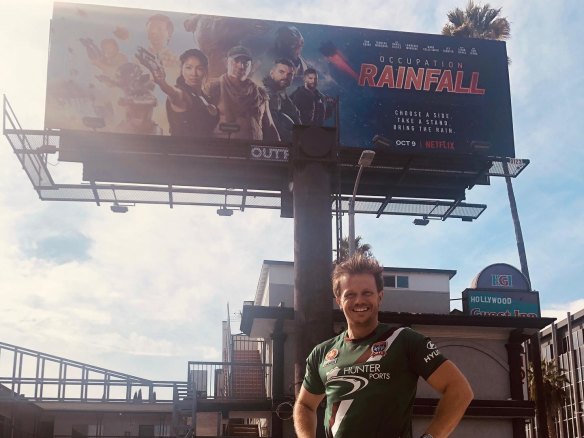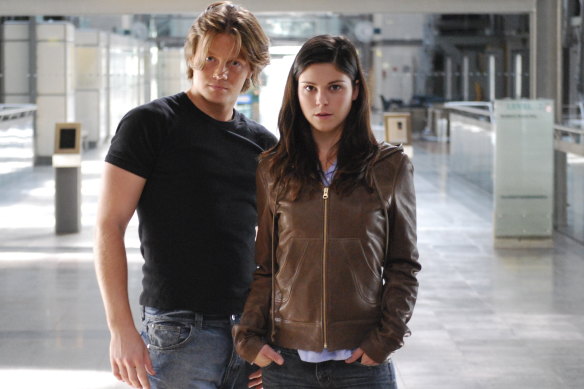
Save articles for later
Add articles to your saved list and come back to them any time.
In the first episode of the hit show Barry there’s a scene in which a class of acting students go to drink and dance in a bar called Residuals, where the eagle-eyed might just about catch a glimpse of a cheque, made out for two cents, pinned to a wall covered in actors’ headshots.
The bar, in Studio City, Los Angeles, is real. And for many a working actor it has offered a sliver of solace at a time when the royalty cheques on which many of them might once have relied are being whittled to almost nothing by the rise of streaming.
Australian actor Zac Garred in front of a billboard for the film Occupation Rainfall on Sunset Boulevard in Los Angeles. The sci-fi sequel was reportedly a hit on Netflix, yet Garred – who acted in and produced it – has never seen a cent in residuals.Credit: Zac Garred
“I swear I’ve had cheques for 500 bucks, and I’ve had cheques for four cents,” says Newcastle-born Zac Garred, who has been working as an actor for 20 years, the last 10 of them in Hollywood.
Any actor who fronts at Residuals with a royalty cheque for less than one dollar can trade it for a free drink, so long as they’re happy for the cheque to be pinned to the wall.
“And because they’re getting these tiny cheques from Netflix and Amazon and Hulu, there’s all these actors who blow in and say, ‘just give us a couple of schooners, thank you so much’,” says Garred. “It’s been a bad time to make an earning as a creative, but a great time to get cheap drinks from Residuals.”
Garred is a passionate supporter of the industrial action that has brought Hollywood to a standstill. As a member of the 160,000-strong actors’ union SAG-AFTRA, he believes the campaign being waged by his union and the Writer’s Guild, both of which are on strike, is essential.
The top issues for Garred, like many others, are residual payments from the streamers and the use of AI.
The former is about bringing the payments from the streamers into closer alignment with those that actors and writers receive from broadcast television. For TV, creatives are paid an initial fee, with further payments triggered by key events such as syndication (the sale to a regional market), repeats, foreign sales, home entertainment releases and so on.
Residuals can be vital in ensuring that an actor earns at least $26,000 a year, enough to qualify for medical insurance, a major consideration in the US where medical expenses for the uninsured can be exorbitant.
Garred says that in his first year in the States, when he appeared in around 60 episodes of the long-running soapie General Hospital, he crossed that threshold. But in his second, and despite booking a guest role in a higher profile series and appearing in a couple of telemovies, he did not.
Under the current agreement with the streamers, which was struck when they were considered “new media” rather than the dominant players in screen entertainment they have become, an actor has little chance of boosting their earnings through residuals.
Garred in General Hospital, his first US show. The 60 episodes he appeared in got him over the earnings threshold to qualify for the all-important medical insurance.
Streamers like Netflix typically take the rights to all (or many) markets in one swoop, with additional payments triggered only if the show hits a certain target in terms of minutes viewed. And that difference can mean an awful lot to an actor or writer’s income.
“I did an episode of NCIS Los Angeles and my on-camera fee was about $7500, and then I get residuals for the rest of my life,” says Garred. “My friend, who did a big show over here on Netflix currently, got paid $1200 as a guest star, with residuals so small it would just be negligible – we’re talking cents.”
Compounding the situation is that the streamers release very little information about how a show has performed, either publicly or to its makers. As one of the stars and producers of the sci-fi movies Occupation and its sequel Occupation Rainfall, Garred has first-hand experience of the challenge that poses.
“We were told by our distributor that both films trended on Netflix, and we could physically see that on the television here in the United States. But as far as I know, we have not received a single dollar from that. And every time you approach the conversation you’re either stonewalled or it’s some opaque vague explanation as to why it hasn’t turned money.
“It is really clandestine,” he says, “and what we’re asking for is basic transparency.”
It’s a mark of how quickly AI is developing that when the writers went on strike on May 2 it seemed something of an afterthought in the campaign, but now it has equal top billing with residuals, and is in danger of stealing the show entirely.
Just days ago, reports surfaced that the Association of Motion Picture and Television Producers (AMPTP), which represents the studios, broadcasters and streamers, had tried to secure the rights to scan background actors for a flat day-rate fee of $187, and that the company producing the scan would own that likeness, and be able to use it any way it wished, for perpetuity. (The AMPTP has denied such a move, though its defence spoke only to the terms of the current agreement, not what they were pushing for.)
The threat posed by this is enormous, says Garred.
Garred, with Kate Bell, in Scorched. The 2008 telemovie also offered early roles to the likes of Deadloch star Kate Box and Love Me’s Bob Morley.Credit: Supp;lied
“The people who are currently graduating from drama schools, who will then be joining the industry in the next few years, are going to be confronted with this existential issue of how do we make a viable living out of an artistic medium that’s trying to eliminate the human element,” he says.
Contact the author at [email protected], follow him on Facebook at karlquinnjournalist and on Twitter @karlkwin, and read more of his work here.
Find out the next TV, streaming series and movies to add to your must-sees. Get The Watchlist delivered every Thursday.
Most Viewed in Culture
From our partners
Source: Read Full Article


